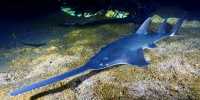The world’s largest predator of ocean tremors could be much larger than predicted in the past. The findings, published in Electronica of Paleontology, show the unexpected results of a program of high school students becoming interested in science and their contradictory inquiries with the enthusiasm of postgraduate students. All specimens of endangered species are rarely found, so medical experts have developed formulas for determining size based on single bones or, in extreme cases, teeth. Megaldon’s name literally means “big teeth” because we have left a few spines aside.
Shark cartilage, which replaces most of the bones in other vertebrates, rarely accumulates fossils. In 2002, equations were published to determine the size of giant extinct sharks from teeth, including megalodons, which dominated the oceans for 20 million years, and others larger than ever to survive. While pursuing a PhD in natural history at the Florida Museum, Dr. Victor Perez realized that these calculations could be transformed into a particularly interesting science project. Perez collaborated with middle-school teacher Megan Hendrickson to help her students 3D print out the original Megaldoon teeth, measure them, and use formulas to determine the shape they came in.
When Perez looked at their results, he noticed that students were getting horribly different answers that could not be attributed to measurement errors. Some people thought the shark was 12 meters (40 feet) long, which would be enough, but others estimated it to be 45 meters (148 feet). The next figure could make it about one and a half times the length of the longest blue whale. He said in a statement, Perez begins with a clear explanation. “I was walking around, checking, did you use the wrong equation? Did you forget to convert your units?”
“But it soon became clear that it wasn’t the students who caused the error. It just wasn’t the equation we did before our equation.” Faced with making almost complete teeth, the students chose how they should be used for their calculations. Although in theory the formulas for allowing different sizes according to the position of the teeth Perez found another tooth in the jaw of the nail, it is larger to calculate the fish from which it came.














